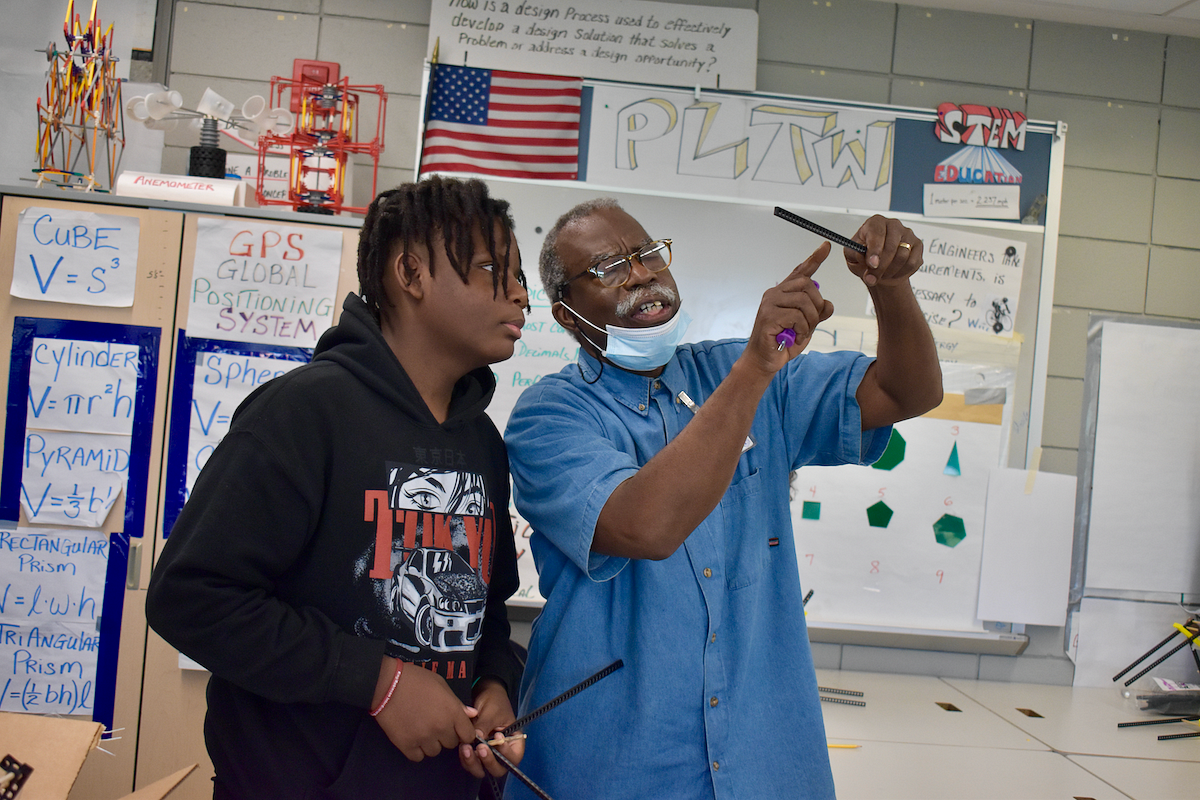
Maya McFadden Photos
King-Robinson STEM teacher Jonathan Hill, with seventh grader Thomas: "They solve their own problems in here."

Eighth grader -- and budding engineer -- Nevaeh James building her hydraulic system.
As her hands worked deftly on a new in-classroom engineering project, King-Robinson eighth grader Nevaeh James glanced back and forth between a basic model of a hydraulic system and her own build — which she had designed to be bigger and with an additional moving claw.
James undertook that work on Friday at King-Robinson Inter-District Magnet School at 150 Fournier St., a day after students concluded a week of state assessments.
This reporter recently visited second and eighth grade STEM classes at the Beaver Hills school, where students used their hands to build everything from Lego replicas of the Windsor Castle to models of hydraulic systems used for heavy machinery like airplanes and cranes.

In Jonathan Hill’s class, eighth grade students created models of an aircraft hydraulic system.
With a video explaining hydraulics playing on the classroom board, students worked independently to each create their own model.
“Once they get an understanding, they have to get a hands on [approach],” Hill said.
Students also incorporate lessons in geometry and physics while building systems that use liquids to transmit force.

Student STEM workbook.
King-Robinson was one of several schools in the New Haven Public Schools (NHPS) district that received a federal manufacturing grant, which brought Goodwin Manufacturing Lab to the Beaver Hills school to expose students to local manufacturing careers.
The school also received two VR headsets to introduce career trainings in the manufacturing field.

Jaiden Rogers shows off air lift project.

Hill refreshes students on plane systems.
During Friday’s lesson Hill checked in with his students mid-class on the lesson’s terminology and gauged their understanding of how hydraulics work in aircrafts.
Jaiden Rogers demonstrated an example of the class’s previous project making a wind lift.
By pointing a small fan toward the blades of a windmill, the blades began to turn from the air flow and cause a cup attached to a string on the windmill to lift thanks to air pressure power.
“So how does this relate to an airplane or a wing of an airplane?” Hill asked the class.
“It’s the same air flow that causes lift,” said one student.
Students also recalled the four dynamics of flight as lift, thrust, drag, weight.

Hill shows off his own handmade hydraulic system.
Hill displayed his own example of a hydraulic system which he engineered to use water pressure pumps to cause mechanical movement and operation of the system.
While working on their own projects the students moved back and forth in the classroom to refer back to Hill’s model.
“They solve their own problems in here,” Hill said.

After James measured a wooden stick to one used in Hill’s model. She then cut her stick to the same length and inserted it to hold her syringe into place.
After completing the foundational structure of the hydraulic system James went on to begin engineering a hydraulic arm claw that could pivot side to side and up and down.


Other students re-watched the demonstration video on their phones as they created their own models.
Some made projects that resembled Hill’s model very closely while others created spins on the structure by adding claws, longer arms, or more movements to their design.

Using personal workbooks Hill teaches his students to act like engineers by drawing out different mechanisms and asking specific questions about the systems on their own.
He’s also taught them to sign off and date their work designs like an actual engineer.

Joshua refers to model to get exact measurements.
Eighth grader Joshua, 14, said he enjoys working hands on in the classroom.
“It’s easy as long as you pay attention and follow the steps,” he said.
Like his peers Joshua bounced between standing at his desk with his own project and looking at the model example made by Hill. He used Hill’s model as the final confirmation before making any decisions for his own project.
Rogers added that she prefers to work with an example model for reference.
“Sometimes videos don’t explain it well or go too fast,” she said.

When asked what key lessons he hopes for students to get from his class lessons, Hill said “the ability to use their hands” and to understand technology in everyday situations.
“They design, they model, they look and recreate systems to scale,” he said. “That’s a skill that’s going to be useful for anything in their lives.”
Hill has worked at King-Robinson for 22 of his 26 total years in education.
“STEM allows others things to come across that aren’t just academic,” he said. “Working with your hands is a skill and this allows for students to feel they don’t have to know everything.”


While eighth grader Angelina (pictured above) moved on to attach a second syringe to her project, she referred to Hill’s model by counting from the seventh hole from the top to confirm where to attach her syringe mechanism.
Upon returning to her seat, she again counted to the seventh hole from the top on her own system to put the syringe in the same place.

Toward the end of class as students cleaned up their remaining pieces and stored them away with their projects until their next class, eighth grader Thomas sought help for where he went wrong with his project.
“I think mine is wrong, it’s not moving,” he said.
Hill took a quick look at Thomas’s project and saw its flaw.
“What tool do you need, guys, to get that mobility? A pivot?” Hill asked the class.
Several students picked up a purple tool known as a reamer.
“You see how the holes have these little teeth in them, that gives it less movement,” Hill told Thomas. “You have to use this, to expand that space so when you put it in there it allows it to pivot.”
Castles Made Of Legos

In Valerie Knowles’ STEM discovery lab, students worked on projects for the school’s International Night. That’s a school-wide event that tasks each classroom with researching and engineering historic landmarks from their assigned state or country.
During Friday’s maker space lesson, students decided how they wanted to spend their class time focused on finishing up their International Night projects.
At one table, some second graders worked on building the Windsor Castle using Legos.
Other students drew their assignments on iPads and read up on the history of the royal residence.

Knowles’ kindergarteners and first graders made skyscrapers from New York and her second graders made replicas of the Windsor Castle using Legos.
“I’m making a castle big enough for a wedding,” second grader Elasia said.
King-Robinsons K‑6 STEM began with support from the Magnet Schools Assistance Program in 2017, and lasted the past five years. This year the school is in its final extension year which was awarded at no cost.

Knowles recalled the challenges of going remote with STEM lessons during Covid. She said it was difficult because “Covid created [a] divide for students who had stuff at home and didn’t have stuff at home.”
Her goal for her students is to have them leave her classroom with the ability to create based on their interests. She also hopes they leave her class knowing how to create with strong problem solving skills and persevering.
“Whatever their love is, I want them to be able to use these skills to design a life to include their interest,” she said. “They’re going to have a life filled with problems and they’re going to have to find a way to solve it.”

Knowles stepped into the role of STEM discovery lab teacher five years ago after previously being the school’s library media specialist. She has taught for 25 years. She has been a classroom teacher for grades first through sixth which, has helped her broaden her STEM work and daily instruction topics in the classroom.
During discovery lab classes, Knowles aims to make her class a place where her students are learning less “traditionally.”
“Maybe they’re not passing the test so they come in here and get a lesson about history, science, or math by being engineers,” she said.
Knowles’ grading system isn’t based on building a perfect project but instead on students demonstrating their problem solving skills throughout the task.
“Mistakes are ok. It is ok to fail. It’s not about perfect design. It’s about the process. Did you follow process? It doesn’t have to be perfect, but did you meet the challenges?” she said.
In the past Knowles has used the maker space to task her students with engineering challenges like designing and creating bridges that can hold a particular weight and extend a certain length.
Using her library media specialist background Knowles often integrates research into students’ discovery lab lessons by having them learn why things like making string bracelets and jewelry has happened throughout history.
To develop student interest in reading, Knowles’ classroom is equipped with books about how skyscrapers are built.
Earlier in the year Knowles had a K‑6 unit in coding where students used online coding programs like CodeMonkey and CodeSpark Academy which later helped them to shift into learning about robotics and to create several variations on coded robots.

See below for other recent Independent articles about teaching, reading, working and studying inside New Haven Public Schools classrooms.
• Cross Culinary Champs Bring Home The Gold
• Barnard’s Classroom Garden Springs to Life
• Ready For College, Hillhouse Senior Persevered
• New School Murals Honor LGBTQ+ Icons
• Truman Students Step Into High Tech
• Student Voices Heard In Citywide Council Vote
• Tiger Squad News Roars Back To Life
• Students Connect Over Story Exchange
• Civics Scholars Prep For Nationals
• Students Pay Attention In Class
• New Reading Program Picked For K‑5
• Books In Hand, Teachers Test Reading Pilot
• LGBTQ Sound Students Find A Safe Space
• Career High School Lifts Every Voice & Sings
• Student Inventors Keep Classmates Upright
• Celentano School Assembly Celebrates Jamaican Connection
• Obama School Takes A Day To De-stress
• Student-Artists Build Houses Out Of Blight
• Black Stars Shine Bright In Preschool’s Orbit
• Hillhouse Coach Cheers Teens To School
• Obama Students“Caught Being STRONG” At Black History Celebration
• Praise, Frustration Follow Star Teacher’s Departure
• Chess Students Learn Power Of The Pawn
• Facing Down Phones, Riverside Adapts
• Refugee Reader Brings Courage To Class
• Middle-School GSA Finds Its Way
• Student Council Gets Down To Governing
• In Class, High-Schoolers Learn To Lead
• High-Schoolers Get Tips From Future Selves
• TAG Turns Into“Wellness Wednesday”
• Volcano Pose Helps Students Erupt, Cool Off
• Gateway Chief Uncovers Student Superpowers
• New Tutoring Site Focuses On Phonics
• Race Finds A Place In The Classroom
• “Little Engineers” Build Boats For Pirate Pete
• Seeking Stability, Cross Principal Hits The Halls
• Hispanic Heritage Takes Center Stage At Career High Fest
• Teacher Tim Takes To TikTok
• Amid Shortage, Teachers Cite Disrespect


This is a wonderful snapshot of the powerful teaching and learning happening as a result of the expert guidance of teachers Knowles and Hill. As a fellow STEM teacher in New Haven, I’m inspired by this article!
Maya - thank you for celebrating the meaningful, relevant work that hard working people are trying to do each and every day with the youth in New Haven schools!